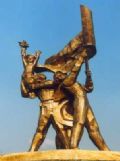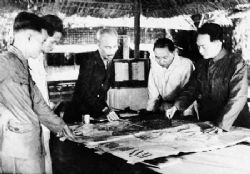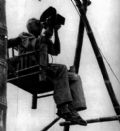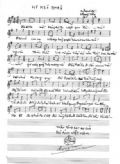|
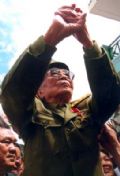
Saluting
heroicnbsp;
Dien Bien Phu.

Noong Nhai villagers
welcoming Gen.nbsp;Vo
Nguyen Giap.

Visiting the French Gen.
De Castries’
Command
Post.
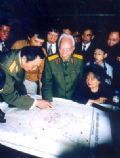
General Vo Nguyen Giap and Senior Lieutenant
General Tran Van Quang (former Chief of the
Operations Department at Dien Bien Phu Campaign) again looking at
the map on the development of the Dien Bien Phu Campaign, atthe General’s Command
Post in Muong Phang.
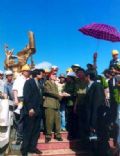
At
the construction site
of the monument “Dien
Bien Phu
Victory” on D1
Hill.

Gifts from the
Northwesterners to the
General.
|
To meet the earnest desire of the ethnic people in the
North West, once again General Vo Nguyen Giap returned to the former
battlefield, where his name is closely attached to the great victory of
the nation, the Dien Bien Phu Victory.
After 1954,
the General returned to Dien Bien many times. But this time, on the
50th anniversary of the triumphal Dien
Bien Phu Victory, his visit was of more significance. The victory festival
in Dien Bien was more joyous, and the local people welcomed him with their
warmest affection.
When the
General appeared at the door of the plane, hundreds of local ethnic
people, in their colourful traditional attire and holding flowers and
flags in hands, greeted him, just like they were welcoming their son back
from a far-away place. The General hesitated at the plane’s stair for a
while, seeming to control his emotions before the meeting with his
comrades as a son coming back to his home village after days of departure
and seeing it with great changes. But above all, it was his affection for
those who had laid down their lives for the final victory. The General
said: “I am glad at the changes that have taken place in this region. But
deep in my soul is a load of grief, for I’m thinking of my
comrades-in-arms who died.” And as he wrote in his memoirs: “Each time I
returned to Dien Bien, I always visited the martyrs’ cemetery located at
the foot of A1 Hill to plant some insence josss-ticks on the graves of my
comrades in memory of them.”
This time,
the first duty the General performed during his trip to Dien Bien was to
again visit the martyrs’ cemetery. People were moved by seeing the old
General, at 93 years old, plant the insence joss-sticks with his trembling
hands and bow in deep respect to the memory of his comrades and other
nameless martyrs.
In the
cemetery, the General planted a pine tree, which is green all the year
round and is a symbol for those who devoted their youth to national
independence.
The
General spent time walking around the battlefield: the trenches through
which the soldiers went forward to fight the enemy, the places where the
soldiers put the explosives to destroy the enemy’s blockhouses, the French
General De Castries’ Command Post. He also visited the monument “Dien Bien
Phu Victory” recently installed on D1 Hill. The General previously had
given comments on the design of this monument, i.e. “The monument must be
installed on a high location, from which the viewers can see the panoramic
view of Dien Bien, a place of historical significance during the Campaign.
The monument should be located on D1 Hill, where our soldiers greatly
contributed their sacrifices and recorded huge feats-of-arms.”
General Vo
Nguyen Giap also called at Muong Phang, where the Command Post of our
armed forces was located during the Dien Bien Phu Campaign. He slowly
walked into the shelter, standing by a rough table, where he held meetings
with different officers to discuss the battle plans. In this tunnel, he
had many sleepless nights before making “an extremely difficult decision”,
i.e. to shift the tactic from “lightening battle, lightening victory” to
“firm fighting, firm advancing”. What was left from that time has been
preserved intact for the present and future generations. They should know
that in this region General Vo Nguyen Giap made a decisive contribution to
the famous Dien Bien Phu Victory, and this Victory has glorified the name
of General Vo Nguyen Giap.
During a
meeting with Dien Bien Province’s Military Command, the General cordially
gave advice – which was also an order from the General to his staff: “The
Number One task, the most important task, that I entrust to you is to
protect, maintain and embellish the relics. The relics in this region are
the blood of our army men and people. To let these relics become damaged
is to be guilty to those who laid down their lives, and our offsprings
will not know how heroically their forefathers lived and fought ... As
soldiers, you have to take the lead in learning and training, and to set
an example for the others in every thing you do.”
The
General visited Noong Nhai Hamlet, not far from Dien Bien Phu City. On the
afternoon of April 25, 1954, the French airplanes dropped bombs on this
hamlet, killing 444 civilians. A meeting full of affection was held
between the former General and Commander-in-Chief of the Campaign and the
veterans and labourers who served the campaign, and the local villagers.
The General was very happy when he was informed that Noong Nhai has become
a cultural hamlet and the villagers have a happy life and that they are
working hard to enrich themselves.
People in
Dien Bien welcomed the old General without ceremonial procedures, but with
warmest affection, i.e. the love between the army men and ordinary people.
They reserved all of their respect and boundless gratitude to the former
Commander-in-Chief,nbsp; an eminent and clear-sighted General, who
glorified the country of Vietnam.
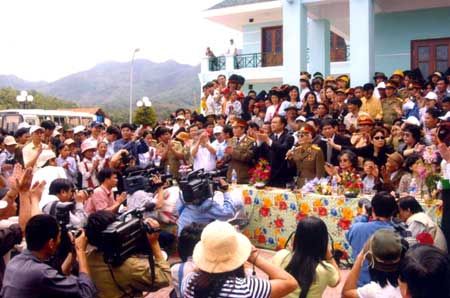
General Vo Nguyen Giap with people
in Muong Phang.
Story:
Son Le - Photos: Tran Dinh
|


